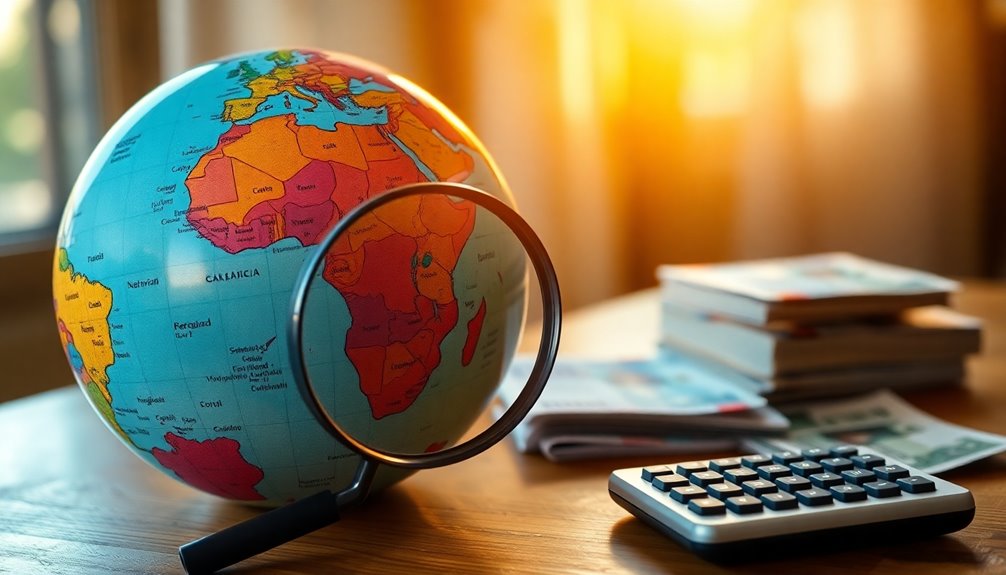Purchasing power parity (PPP) is a concept that helps you compare the value of currencies by looking at how much a set basket of goods costs in different countries. It suggests that exchange rates should adjust so that you can buy the same amount of goods everywhere. Developed early in the 20th century, PPP aids in assessing living standards, economic well-being, and even influences trade decisions. While it provides important insights, its application can have limitations due to local cost differences and consumption patterns. If you want to grasp its full significance and how it affects the global economy, there's more to discover.
Key Takeaways
- Purchasing Power Parity (PPP) is an economic theory that suggests exchange rates should equalize purchasing power between countries.
- There are two types of PPP: Absolute Purchasing Power Parity (APPP) and Relative Purchasing Power Parity (RPPP).
- PPP is measured using the cost of a standardized basket of goods across different countries.
- It helps assess living standards, currency valuation, and informs international trade and investment decisions.
- Limitations of PPP include differences in local consumption patterns and challenges in finding comparable goods across markets.
Conceptual Framework Overview

Understanding Purchasing Power Parity (PPP) is essential for grasping how exchange rates reflect economic realities across countries.
At its core, PPP is an economic theory that states price levels between two countries should equalize when currencies are exchanged. This means that goods will cost the same after conversion.
You'll find two main types of PPP: Absolute Purchasing Power Parity (APPP), which focuses on a specific basket of goods, and Relative Purchasing Power Parity, which adjusts for inflation over time. Market exchange rates often differ due to varying purchasing power, which highlights the significance of understanding these concepts.
Calculating PPP involves comparing the currency needed to purchase that basket in different economies. Tools like the Big Mac Index and OECD price index help simplify these comparisons, making it easier to assess living standards and economic productivity globally.
Understanding Purchasing Power Differences

Purchasing power differences between countries highlight how economic productivity and standards of living vary around the world. By using a "basket of goods" approach, purchasing power parity (PPP) provides a clearer picture of these disparities. This method adjusts GDP figures for price level differences, allowing you to assess relative economic productivity and living standards accurately. Inflation and deflation significantly influence purchasing power, impacting how far your money goes. Additionally, local costs and consumption patterns can lead to variations from PPP theory. While PPP helps compare costs of goods and services and aids policymakers, remember it doesn't always reflect real-world conditions due to trade barriers and local economic factors. Understanding these differences can enhance your global economic perspective, as PPP exchange rates are crucial for international economic analysis.
Currency Value Fluctuations Impact Purchasing

As currency values fluctuate, you may notice significant impacts on your purchasing power and overall economic landscape.
A weaker currency makes your exports cheaper, potentially boosting trade competitiveness, while raising the cost of imports, which can lead to higher prices domestically. Currency fluctuations are influenced by market demand and supply dynamics and can occur due to various economic, political, and social factors.
Conversely, a strong currency benefits you as a consumer by making imports cheaper, but it can hurt domestic industries reliant on exports.
Inflation plays a role too; when currency depreciates, import costs rise, increasing domestic inflation.
If inflation remains low, your currency's value can strengthen, preserving your purchasing power.
Pros and Cons of Parity

While evaluating the pros and cons of purchasing power parity (PPP), you'll find that it offers valuable insights into global economics, yet it also has significant limitations.
On the positive side, PPP allows you to compare economic productivity and living standards between countries. It provides a stable metric over time, helping you understand the relative costs of goods and services. Additionally, the PPP exchange rate indicates equal purchasing power across locations, which can enhance your understanding of international price dynamics.
However, there are challenges. Finding comparable baskets of goods can be tricky due to varying consumption patterns. Additionally, local costs, taxes, and trade barriers can distort PPP calculations, making them less accurate.
Ultimately, while PPP can guide your decisions, you should be aware of its measurement limitations and the complexities of real-world economics.
Price Level Analysis

Understanding price levels is key to grasping how purchasing power parity (PPP) functions in real-world economics. At its core, PPP assumes that in a perfect market, identical goods should cost the same everywhere, minus transaction costs. To analyze price levels, economists use a basket of goods that represents various consumer items, services, and construction projects. This basket approach helps offset errors from comparing single goods. In addition, pricing analysis is crucial for evaluating how price levels reflect consumer demand and market dynamics.
Market Volatility Implications

Market volatility can significantly impact various aspects of the economy, shaping how consumers, businesses, and investors behave.
When markets fluctuate, you might notice higher interest rates, making borrowing more expensive for you and businesses. This uncertainty often leads you to spend less, as you become cautious about your financial future.
Businesses may struggle, especially those relying on discretionary income, which can affect their growth and hiring decisions. Additionally, lenders might tighten their criteria, limiting access to credit. During times of high volatility, businesses often face increased challenges in securing loans due to higher borrowing costs.
As an investor, you could feel hesitant to make significant investments due to increased risk.
Ultimately, these dynamics create a ripple effect, influencing decisions across the board and altering your financial landscape during uncertain times.
Digital Currency Adoption Trends

How is the landscape of digital currency evolving in today's economy?
You're witnessing a significant shift as clearer regulations emerge, particularly in the U.S., which could accelerate crypto adoption.
With changes in SEC leadership, a pro-crypto environment seems likely. Countries like Morocco and South Korea are on the brink of legalizing cryptocurrencies, expanding access and acceptance.
Institutional adoption is also on the rise; expect countries to double their Bitcoin reserves by 2025. Bitcoin becoming a strategic reserve asset is anticipated to further solidify its role in national financial strategies.
Technological advancements like Ethereum's new features and the increased use of stablecoins are enhancing transaction efficiency.
As Bitcoin becomes a strategic reserve asset for many nations, you might find that digital currencies are becoming a cornerstone of modern financial systems, reshaping economic landscapes worldwide.
Monitor Inflation Rates Regularly

As inflation continues to impact economic stability, regularly monitoring inflation rates is essential for making informed financial decisions. You can utilize sophisticated tools like time series filters to track real-time inflation changes. While standard diffusion indexes measure price changes, they might fall short in fully explaining inflation rates. To enhance accuracy, consider adjusting for tail behavior by analyzing the entire distribution of price changes. Employ empirical relationships from pre-pandemic data to gauge current trends. Keep an eye on various price indexes, including CPI and PCE, which reflect typical consumer spending. Notably, the Federal Reserve uses PCE as its primary inflation measure to gauge economic conditions and guide monetary policy.
Frequently Asked Questions
How Does Purchasing Parity Affect International Trade Agreements?
Purchasing parity impacts international trade agreements by influencing how you evaluate market access and competitiveness.
When you're negotiating, you consider tariffs, subsidies, and non-tariff barriers, all shaped by purchasing parity. This affects the terms under which goods and services are traded.
Additionally, it guides long-term policy decisions, helping you align economic strategies with the realities of global markets, ultimately ensuring that your country's trade agreements are beneficial and sustainable.
Can Purchasing Parity Impact Global Investment Strategies?
So, you think investing's just picking stocks and hoping for the best? Think again!
Purchasing parity can dramatically impact your global investment strategies. It reveals currency misalignments and signals when to buy or sell assets.
By understanding these dynamics, you're not just throwing darts in the dark; you're honing in on undervalued opportunities.
Ignore it, and you might as well toss your portfolio into a wishing well! Invest smart, not blindly.
Are There Tools to Calculate Purchasing Power Parity?
Yes, there are several tools to calculate purchasing power parity (PPP).
You can use the Consumer Price Index (CPI) to compare prices of a standardized basket of goods across countries. Economic organizations like the World Bank and IMF also provide PPP reports.
Simplified methods, such as the Big Mac Index, allow you to quickly gauge PPP by comparing the price of a Big Mac in different countries.
These tools help you understand currency valuation.
How Does Purchasing Parity Relate to Cost of Living Adjustments?
Purchasing parity directly impacts cost of living adjustments by reflecting how much you can actually buy in different locations.
When you understand local price levels, you can see how changes in costs affect your real income. If you're moving or comparing salaries, adjusting for purchasing parity ensures you're considering those cost differences.
It helps maintain your purchasing power, so you can make informed decisions about where to live or work.
What Role Do Governments Play in Purchasing Power Parity?
Have you ever wondered how governments ensure their economic data reflects true living standards? They play a crucial role in purchasing power parity by adjusting GDP figures to highlight real currency value.
Conclusion
In a world where currency dances to the tune of market fluctuations, understanding purchasing parity becomes your compass. By grasping how purchasing power varies, you're better equipped to navigate the stormy seas of inflation and price levels. Keep an eye on digital currency trends, as they're reshaping the financial landscape. Remember, staying informed is your anchor; it'll help you weather economic shifts and seize opportunities when they arise. Embrace this knowledge, and you'll sail smoothly into your financial future.









